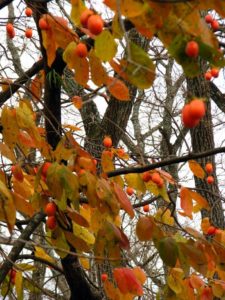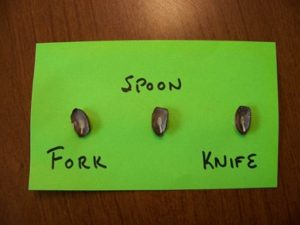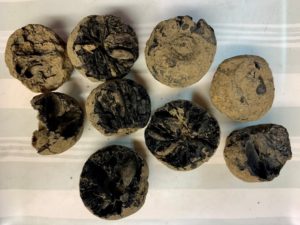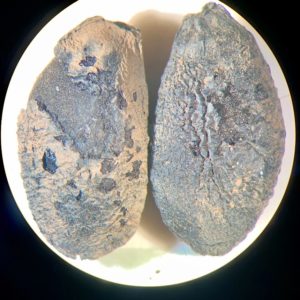November: Persimmon (Diospyros virginiana)

“Persimmons” by MShades, CC BY 2.0.
It’s persimmon season! In late fall the yellow-green berry fruits of the persimmon trees ripen into beautiful yellow-orange and orange-red colors, having sweetened and ready for eating. Not only do these fruits mark the coming of winter with their appearance, but their seeds are also used in weather folklore to determine the severity of the forthcoming winter season. It is said that when the seeds are cut open the shape of the cotyledon (embryonic leaf) inside will tell if there will be a mild winter (fork shape), a cold/icy winter (knife shape), or if there will be an abundance of snow (spoon shape). In fact, a local news station here in Knoxville, WVLT, spoke to the Fort Loudoun State Historic Park Manger Eric Hughey about the process. Hughey put the seeds to the test just a few weeks ago and found an unusual unanimous result – all spoons! We may be in for a snowy winter this year in Knoxville.

“Weather forecast” by MUExtension417, CC BY-NC 2.0
Characteristics:

“Common persimmon (Diospyros virginiana) flowers and underside of leaves” by Cathy Flanagan, CC BY-NC-SA 2.0
Persimmons (Diospyros virginiana), belonging to the Ebony family (Ebenaceae), are very hardy and adaptable with immunity to insects and diseases. They also can be helpful with erosion control given their deep taproot. Persimmon trees are often found along roadsides or in thickets in open fields. They thrive in full sun but are also shade tolerant and can be found in understory areas as well. Mature persimmon trees can grow from 16-39 (-69) feet tall with grey and blocky bark. The ideal fruit-producing age ranges from 25 to 50 years, although fruits can sometimes be found on trees as young as 10 years. Typically, persimmon trees will bear fruits every two years, which typically have widths of 2-5 centimeters and hold up to eight flat seeds. An abundance of wildlife enjoys the persimmon fruit and aid in seed dispersal. The deciduous simple leaves are alternately arranged with ovate to elliptic shape. The species is dioecious, with male and female flowers borne on separate trees, flowering in the months of March through June.
Historical Uses:
Ethnohistorian Charles Hudson stated that persimmons were the most important fruit in the southeast among Native Americans, being incorporated into native diets since at least the Paleoindian time period (over 12,000 years ago). Persimmons are even mentioned in the Cherokee myth of “The Terrapin’s Escape from the Wolves,” which begins with a possum and a terrapin hunting for persimmon. When they come upon a tree with ripened fruit, the possum climbs the tree and begins to toss the persimmons down to the terrapin, but a wolf comes along and begins to take the persimmons the possum is tossing down. The possum eventually throws a persimmon large enough that causes the wolf to choke and die.
Persimmons develop a date-like flavor in the late fall and early winter and must be eaten after they have ripened, softened, and fallen to the ground. Native American groups used persimmon fruits as food; often dried and made into cakes or a sort of bread that are well documented in the De Soto expeditions. Historically, the Cherokees also used persimmons for pudding, but used other parts of the plant for various purposes as well. They dried the leaves and steeped them in boiling water to create a light tea with a taste similar to sassafras.
Before the fruits ripen, the pulp within the persimmon is very astringent, and accordingly Southeasterners historically used it medicinally. This included use of the persimmon to treat sore throats and mouths; they also made into a syrup for thrush, and teas to help with liver ailments. Persimmon was one of the ingredients used in a steam bath for gastrointestinal aid and was also used as a wash for hemorrhoids. It could also be boiled down to remedy bloody discharge of bowels. The bark itself had medicinal uses as well: it was chewed for heartburn, and used to create an infusion along with alder, white walnut, and wild cherry bark for toothache relief. Cold water poured over the bark was also drunk to treat bile.
Archaeology of Persimmons:

Whole persimmon fruits from Structure 1, Feature #2, 40WM10 Kellytown. Courtesy of Kelly Santana.
Just outside of Nashville, Tennessee, is a site referred to as “Kellytown” (40WM10), a late Mississippian period village located north of the Little Harpeth River that was excavated by archaeologists with the Tennessee Department of Transportation in 1999 and 2002. Mississippian culture in middle Tennessee, also referred to as “Middle Cumberland Culture” within the Central Basin region, thrived from approximately AD 950 to 1450 and is comparable to other southeastern Mississippian sites.
Approximately 1486.4 grams of carbonized archaeobotanical remains were recovered from excavation and analyzed by Andrea Shea Bishop. Fruits and seeds from seven native species and five cultivated species were identified, but most noteworthy were the persimmon fruits. Within Structure 1, nine whole persimmon fruits, more than 200 persimmon fruit fragments, and 43 persimmon seed fragments were identified, with a total weight of 97.8 grams. What is so unique about these persimmon fruits (shown below) is the near perfect condition of their preservation that is so rarely found in archaeological sites. Their presence on the floor of Structure 1 tells us not only that the persimmons were unprocessed and had not yet been dried, but also gives us insight to the seasonality of when people occupied the house and when it was burned and destroyed: late fall/early winter, when persimmons are ripe!

Persimmon seeds from Structure 1, Feature #2, 40WM10 Kellytown, under the microscope. Courtesy of Kelly Santana.
In the photos below, carbonized seeds (some of which were found within these preserved fruits) are shown from the view of under the microscope. The wrinkly outer seed coat is clearly visible.
Can you see the embryonic leaf inside of half of a persimmon seed shown below?

Half of a Persimmon seed from 40WM10 Kellytown, under the microscope. Courtesy of Kelly Santana.
Persimmon Recipe:
There are so many ways to incorporate persimmons on your dinner table this season, although mostly of the baked-good variety! A quick search will provide you with recipes for cookies, breads, puddings, and more. Below is a shared 150-year-old recipe for “Persimmon Pudding” from Edith Catherine Fry Terrell, that won a prize at a Persimmon Festival in 1953. The recipe received national attention after being shared by her daughter Ro Pettiner, although originally created by her grandmother, Grace Estelle Pickens.
Edith Catherine Fry Terrell’s Award-winning Persimmon Pudding
Pettiner recommends fresh persimmon pulp gathered from fallen ripe persimmons, but frozen is okay as well. If persimmons cannot be found in your area locally (where foraging is allowed), they may also be found online and sometimes at local farmers markets. The recipe can also be doubled and baked in a 9-by-12-inch rectangular pan.
1 cup pureed American persimmons
1/4 teaspoon baking soda
1 egg
1 1/4 cups sugar
1 cup flour
2 teaspoons baking powder
l/4 teaspoon salt
l/2 teaspoon cinnamon
1 teaspoon vanilla
Dash of nutmeg
1 1/4 cups milk
2 tablespoons butter, meltedGenerously grease an 8-by-8-inch baking pan. Preheat oven to 325 degrees.
Using a wooden spoon, stir baking soda into persimmon pureed and beat well. Add egg and sugar. Beat well. Add flour, baking powder, salt, cinnamon, vanilla and nutmeg. Beat well. Stir in the milk slowly and then the butter. Beat well.
Carefully pour mixture into the greased baking pan. Bake in the pre-heated oven for 50 minutes. Do not overbake. Makes 6 to 8 servings.
Source: Ro Pettiner
For More Information:
Barker, Kline, and Bishop. 2013. Archaeological Investigations at Kellytown (40WM10): A Fortified Late Mississippian Village in Middle Tennessee’s Harpeth River Drainage, Davidson and Williamson Counties, Tennessee. Tennessee Department of Transportation, Environmental Division, Archaeology Section, Nashville, Tennessee.
Biro, Liz. 2017. “This famous persimmon pudding recipe is 150 years old”. Indy Star.
Hamel, Paul B., and Mary U. Chiltoskey. 1975. Cherokee Plant and Their Uses – A 400 Year History. Herald Publishing, Sylva, North Carolina.
Hudson, Charles. 1976. The Southeastern Indian. The University of Tennessee Press, Knoxville, Tennessee.
Kavasch, Barrie. 1979. Native Harvests- Recipes and Botanicals of the American Indian. Vintage Books, New York.
Moerman, Daniel E. 1998. Native American Ethnobotany. Timber Press, Portland, Oregon.
Mooney, James. 1995. Myths of the Cherokee. Dover Publications, Inc., New York.
Noël, Paige. 2021. “Could persimmon seeds predict what kind of winter we will have?”.
Swanton, John R. 1946. The Indians of the Southeastern United States. Greenwood Press, Publishers, New York.
US Department of Agriculture, Natural Resources Conservation Service. 2021. PLANTS Database. Electronic document.